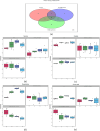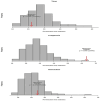Time-series metabolomic profiling of SARS-CoV-2 infection: Possible prognostic biomarkers in patients in the ICU by ¹H-NMR analysis
- PMID: 40608744
- PMCID: PMC12225815
- DOI: 10.1371/journal.pone.0327244
Time-series metabolomic profiling of SARS-CoV-2 infection: Possible prognostic biomarkers in patients in the ICU by ¹H-NMR analysis
Abstract
The global impact of SARS-CoV-2, which causes COVID-19, remains significant, being intensified by the emergence of variants. Comprehensive metabolomic studies aimed to elucidate the distinctive metabolic footprint of the virus. For critically ill patients with COVID-19 in the intensive care unit (ICU), longitudinal monitoring based on their prognosis is crucial to optimize treatment outcomes. This study retrospectively investigated the temporal changes in the metabolomic profiles of patients admitted to the ICU with COVID-19, who were categorized into three prognostic groups: healthy discharged (HD), polyneuropathic syndrome (PS), and Exitus. In total, 32 serum samples collected in April 2020 at regular intervals (four samples per patient) and stored at -80°C, were analyzed using proton nuclear magnetic resonance (1H-NMR) spectroscopy. Significant (p < 0.05) prognostic changes in creatine and tyrosine levels were revealed by two-way analysis of variance (ANOVA) and ANOVA-simultaneous component analysis (ASCA). Furthermore, supervised random forest analysis demonstrated excellent group prediction with a 21.9% out-of-bag error rate based on prognosis. Specifically, creatine levels were highest in the PS group, whereas tyrosine levels were highest in the Exitus group. However, no metabolite displayed significant changes over time. In addition, metabolic pathway analysis using the Kyoto Encyclopedia of Genes and Genomes database indicated that the most significantly impacted pathway (p < 0.05) across different prognostic groups was "phenylalanine, tyrosine and tryptophan biosynthesis." This preliminary study emphasizes the need for time-series analysis of samples from unvaccinated patients with varying prognoses, providing valuable insights into the metabolic impact of COVID-19.
Copyright: © 2025 Matpan et al. This is an open access article distributed under the terms of the Creative Commons Attribution License, which permits unrestricted use, distribution, and reproduction in any medium, provided the original author and source are credited.
Conflict of interest statement
The authors have declared that no competing interests exist.
Figures






Similar articles
-
Signs and symptoms to determine if a patient presenting in primary care or hospital outpatient settings has COVID-19.Cochrane Database Syst Rev. 2022 May 20;5(5):CD013665. doi: 10.1002/14651858.CD013665.pub3. Cochrane Database Syst Rev. 2022. PMID: 35593186 Free PMC article.
-
Proteomic and metabolomic analysis of serum in women infected with COVID-19 during late pregnancy.Front Immunol. 2025 Jun 11;16:1589239. doi: 10.3389/fimmu.2025.1589239. eCollection 2025. Front Immunol. 2025. PMID: 40568583 Free PMC article.
-
Rapid, point-of-care antigen tests for diagnosis of SARS-CoV-2 infection.Cochrane Database Syst Rev. 2022 Jul 22;7(7):CD013705. doi: 10.1002/14651858.CD013705.pub3. Cochrane Database Syst Rev. 2022. PMID: 35866452 Free PMC article.
-
Metabolic signature of COVID-19 progression: potential prognostic markers for severity and outcome.Metabolomics. 2025 May 21;21(3):70. doi: 10.1007/s11306-025-02264-w. Metabolomics. 2025. PMID: 40399692 Free PMC article.
-
Antibody tests for identification of current and past infection with SARS-CoV-2.Cochrane Database Syst Rev. 2022 Nov 17;11(11):CD013652. doi: 10.1002/14651858.CD013652.pub2. Cochrane Database Syst Rev. 2022. PMID: 36394900 Free PMC article.
References
-
- COVID-19 Weekly Epidemiological Update Global overview. 2023.
-
- Kimhofer T, Lodge S, Whiley L, Gray N, Loo RL, Lawler NG, et al. Integrative Modeling of Quantitative Plasma Lipoprotein, Metabolic, and Amino Acid Data Reveals a Multiorgan Pathological Signature of SARS-CoV-2 Infection. J Proteome Res. 2020;19(11):4442–54. doi: 10.1021/acs.jproteome.0c00519 - DOI - PubMed
-
- Páez-Franco JC, Torres-Ruiz J, Sosa-Hernández VA, Cervantes-Díaz R, Romero-Ramírez S, Pérez-Fragoso A, et al. Metabolomics analysis reveals a modified amino acid metabolism that correlates with altered oxygen homeostasis in COVID-19 patients. Sci Rep. 2021;11(1):6350. doi: 10.1038/s41598-021-85788-0 - DOI - PMC - PubMed
MeSH terms
Substances
LinkOut - more resources
Full Text Sources
Medical
Miscellaneous

